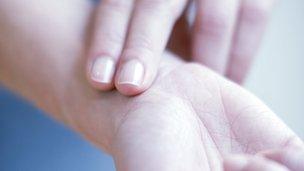George, the patient we have been following through the Understanding AFib series, found it easy to recognize when his heart was in atrial fibrillation (AFib) and beating very quickly (at 150 beats per minute). Like a heart dancing without rhythm, the rapid, irregular heart rate made him unable to exert himself.
To get the most accurate reading, put your finger over your pulse and count the number of beats in 60 seconds. Your resting heart rate is the heart pumping the lowest amount of blood you need because you’re not exercising.
- Checking for pulses in your feet The simplest test to screen for PAD is to have your physician check for the pulses in your feet during a routine physical exam. In each foot, there should be two pulses that are easily detected by a trained physician. This test is performed to.
- Pulse check location – for an infant, it is easiest to check for a pulse using the brachial artery. To locate the brachial artery, place 2 or 3 fingers on the inside of the upper arm between the shoulder and elbow. Press the fingers gently for 5 to 10 seconds to feel for a pulse.
- Check for a pulse for no more than 10 seconds in the carotid artery of the neck. Compressions: Hard and Fast. 30:2 at 100- 120/minute. Depth of compressions 2” minimum to 2.4” maximum. Head tilt/chin lift. Check mouth for obstruction, foreign matter for choking victims. Use jaw thrust if suspected neck.

Once George started the beta blocker, metoprolol, to slow down his heart, he felt better. But it became more difficult for him to tell whether his heart was in a normal pattern of beating or in AFib.
His doctor ordered a three-day, continuous electrocardiogram (ECG) monitor that confirmed he was in AFib several times for an hour at a time. He would have benefited from knowing when he was in AFib earlier, without having to wait for the test results.

In previous posts, we discussed blood thinning medications that reduce the chances of stroke and medications used to slow down the heart. But as you might guess, drugs are only part of the strategy to remain healthy with AFib.
Several other important, heart-healthy strategies, include:
- Avoid stimulants, including excessive caffeine, that can speed up the heart.
- Take your heart-rate control medications consistently. Heart rates can speed up very quickly when beta blockers are stopped abruptly.
- Limit alcohol consumption. It is generally safe for women to have one drink per day and for men to have two.


Checking Pulse In Leg
It is also very useful to recognize when you are in AFib. While some people immediately know when their heart is in AFib because of palpitations, chest fluttering, shortness of breath, or other symptoms. Others may not have obvious indicators.
Checking Pulse On Wrist
You can tell you are in AFib by paying close attention to whether your heartbeat is regular or irregular:
- Begin by placing your right hand on the left side of your chest while seated and leaning forward.
- Position your hand so that you feel your heartbeat most strongly with your fingertips.
- A normal heart rhythm should feel like a regular drum beat cadence; you can usually anticipate when each beat will come after the last beat.
- Because heart rate and the strength of the heartbeat can vary with breathing, sometimes holding your breath for a few seconds is helpful. With an irregular rhythm, it will be hard to predict when the next beat will come.
- In addition, some irregular beats will be softer (less strong) than other beats, so the strength as well as the timing may not be consistent.
An ECG or continuous ECG monitor is the only foolproof way to tell if AFib is present, but learning to recognize symptoms and gain greater awareness of when it is occurring can be a crucial part of managing your health.
A second self-care skill is the ability to measure your heart rate. A very rapid heart rate can tell you when you need to seek medical care. Remember, an optimal heart rate is between 50 and 100 beats per minute when you are at rest.

To measure your heart rate:
- Place your right hand over your heart so that you feel your heart beating under your fingertips.
- Use a watch or timer and count the number of beats for 15 seconds.
- Be sure to count all heartbeats; including beats that are not as strong or that come quickly following one another.
- Take the number of beats you’ve counted and multiply it by four. For example, if you count 30 beats in 15 seconds, then you would calculate 4 x 30 = 120 beats per minute.
- Repeat this process three times right away, writing down each heart rate to later share with your doctor.
It is also possible to use an automatic blood pressure cuff that measures heart rate.
In the next blog post, I'll review the drugs and procedures that may help the heart return to a normal, regular rhythm.
Checking Pulse Clip Art
This is the fifth post in the Understanding AFib series to help patients with atrial fibrillation live healthier lives. George H. is an actual patient with some details altered to protect his confidentiality.
Checking Pulse Child
Randall Stafford, MD, PhD, is a professor of medicine at Stanford and practices primary care internal medicine. Stafford and Stanford cardiologist Paul Wang, MD, lead an American Heart Association effort to improve stroke prevention decision-making in atrial fibrillation.
Checking Pulse Rate
Illustration by Vinita Bharat/Fuzzy Synapse
